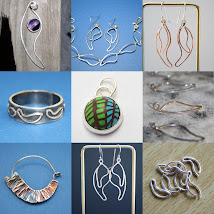
I am amazed at my success with applying a liver of sulphur/sulfur patina to one of my
fold formed earrings. I would have been happy with black, but getting lovely colours was quite a bonus! Whether I shall be able to repeat this is, of course, quite another thing.

I started with the
ripple band ring. I scrubbed it with soap and water, then applied pumice powder using a glass brush.

I used liquid liver of sulphur, sold by an art clay supplier who supplied it in the little bottle shown here. I added the liquid to hot tap water in the tub on the right. The red liquid came out of the bottle in a little glug rather than drops, but there were probably 10 drops or so. The ring was suspended from a thread and submerged for about 30 seconds.

This is how the ring looked after rinsing. I sanded the surface of the ripples with 600 grit wet and dry paper, but thought that the oxidation wasn't dark enough, so dipped the ring for a further half minute.

Here's the ring after its second dunk, and after sanding the ripples and the edges to remove the oxidation there. I'm pretty pleased with it.

Then I found my
fold-formed earrings. I decided just to try the nicer one, which has more regular surface indentations. This time I didn't use any pumice powder, but just scrubbed the earring with soap and water, then rinsed and dried it. It took much longer for a colour change to take place this time, perhaps because the solution had cooled down, or because there was soap or grease left on the surface. The inside of the shape (which hadn't been scrubbed) turned black first.

When the silver had turned a copper-like colour, I removed it from the liver of sulphur, rinsed it and used wet and dry paper on the surface. Then I returned it to the solution for a couple of minutes, before rinsing and sanding again.

And this was the result.
 I was really excited by the results of my first experiments with liver of sulphur (sulfur). Here's an update.
I was really excited by the results of my first experiments with liver of sulphur (sulfur). Here's an update. 





































